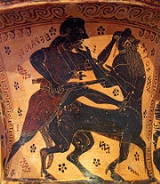
Nessos Painter
Encyclopedia

On the neck of an amphora in the National Archaeological Museum of Athens
National Archaeological Museum of Athens
The National Archaeological Museum in Athens houses some of the most important artifacts from a variety of archaeological locations around Greece from prehistory to late antiquity. It is considered one of the great museums in the world and contains the richest collection of artifacts from Greek...
, the painter depicted Nessos fighting Heracles
Heracles
Heracles ,born Alcaeus or Alcides , was a divine hero in Greek mythology, the son of Zeus and Alcmene, foster son of Amphitryon and great-grandson of Perseus...
. The figure is also marked with the name 'Netos'. John D. Beazley
John Beazley
Sir John Davidson Beazley was an English classical scholar.Born in Glasgow, Scotland, Beazley attended Balliol College, Oxford, where he was a close friend of the poet James Elroy Flecker. After graduating in 1907, Beazley was a student and tutor in Classics at Christ Church, and in 1925 he...
, the authority on Attic vase painting, attributed the name 'The Nessos Painter' to this artist - preferring the Attic dialect form of the name Nessos/Netos. Later, after new finds in Athens and in a cemetery outside the city, paintings of chimera
Chimera (mythology)
The Chimera or Chimaera was, according to Greek mythology, a monstrous fire-breathing female creature of Lycia in Asia Minor, composed of the parts of multiple animals: upon the body of a lioness with a tail that ended in a snake's head, the head of a goat arose on her back at the center of her...
were identified with this painter and Beazley subsequently tried to use the name 'Chimera Painter' - but it failed to find general acceptance.
The painter's early works are particularly reminiscent of the proto-Corinthian style, using space-filling ornamentation similar to that of 'the Painter of Berlin'. However, with the eponymous 'Nessos' vase, he established a style distinct from the Corinthian style, which at this stage (late 7th century BCE) was marked by clear clay fields and contour drawing. This was the critical distinction of the new black figure style. Most of his work falls in the last quarter of the 7th century, during the transition from the proto-Corinthian to Corinthian. He did not completely abandon contour drawing, but by introducing two or more etched lines he introduced a new sharpness and suggestion of form - most particularly with curls, feathers and spring designs.
The other distinctive feature of the Nessos painter was the scale of some of his work with some pieces - mixing bowls for example - over a meter in height. The Nessos painter is considered by many as the essential link between classical Attic vase painting and the new Corinthian style, which uses animal motifs and mythological figures and scenes. It is sparing with its use of white opaque but often uses red pigment to intensify the red colour of the clay. Perhaps under the influence of Egyptian
Ancient Egypt
Ancient Egypt was an ancient civilization of Northeastern Africa, concentrated along the lower reaches of the Nile River in what is now the modern country of Egypt. Egyptian civilization coalesced around 3150 BC with the political unification of Upper and Lower Egypt under the first pharaoh...
figure painting, an idiom developed by which white faces indicated women, red faces men - and indeed up to the end of the black figure period, white was used to signify female faces.
See also
- National Archaeological Museum of AthensNational Archaeological Museum of AthensThe National Archaeological Museum in Athens houses some of the most important artifacts from a variety of archaeological locations around Greece from prehistory to late antiquity. It is considered one of the great museums in the world and contains the richest collection of artifacts from Greek...

